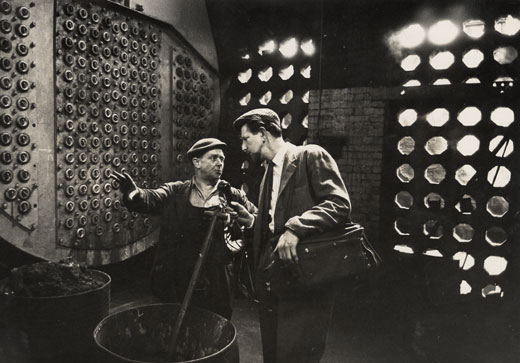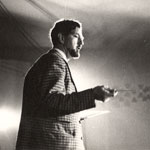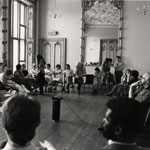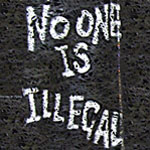
Introduction: Britain in the 1950s: You’ve never had it so good?
In July 1957, Prime Minister Harold Macmillanwas reported in The Times newspaper as saying “Let us be frank about it: most of our people have never had it so good”. A year later, a landmark series of BBC broadcasts called ‘The Radio Ballads’ would challenge this myth. Produced by Charles Parker, these documentaries attempted to uncover the hidden, real life stories of what was happening in a divided Britain. The first of these programmes, the ‘Ballad of John Axon’ was broadcast on July 2nd, 1958, when British society confronted many new challenges linked to work and immigration.
On the same day that ‘The Ballad of John Axon’ was broadcast, The Birmingham Mail showed a local landscape confronted with injustice and discrimination. One story ‘The man from Easter Island’ described the anxious situation of an ex-National Service man in Edgbaston who had previously served on Christmas Island, where Britain tested its first nuclear H bombs: “Because of my hands, I have been unable to work since I was demobbed in November”. The government had offered the insulting choice of 104 weeks sickness allowance, or £75 on which to survive. Another story, ‘Musicians act on the Colour Bar’, highlighted racial exclusions in Birmingham: “Officials of the Musicians Union are to discuss the Birmingham Casino colour bar with the directors of Mecca Ltd., who control this and other ballrooms throughout the country. This week Mecca decided that coloured men- other than Indians and Pakistanis- cannot be admitted to Casino dances unless accompanied by a woman partner.”
Such stories indicate the local and national atmosphere in which the Radio Ballads emerged. Fittingly, when ‘The Ballad of John Axon’ was later released by Argo press on vinyl, the sleeve showed a photograph of the train wreck in which John Axon the railway man had lost his life. The shocking image was a testimony to the bravery of Axon in staying on his train until the very end (and the starting point for the Radio Ballad story). However, the twisted metal of the train suggested a wider message: the artists discussed in this learning package perceived a society on a destructive collision course. These ‘people’s performers’ wanted to re-establish a sense of social cohesion by listening to people’s everyday experiences and to celebrate hidden traditions connected to music, industry and culture being threatened in the new age of the motorway, the Colour Bar and the H-bomb. (For a more detailed context for mid-twentieth century Birmingham, go to Migration and Settlement or Campaigning for Social Justice).
Bridging the Gap: From ‘The Radio Ballads’ to ‘Banner Theatre’
“The fundamental basis of the Radio Ballads is the peoples’ experience expressed in their own words. This involves an extensive field-sound recording programme by Ewan MacColl, Peggy Seeger and Charles Parker, together, taking tape machines into peoples homes, factories, workshops, clubs, etc., and recording long conversations in which workers are encouraged to describe their way of life in-depth. These recordings, running into between 100 and 200 hours of speech, are the concrete ground-base of the ultimate programme.” (Charles Parker essay, “The Radio Ballads”, 1972)
To capture the crackling energy and social tension of the age, Parker, MacColl and Seeger’s technique was to blend folk music traditions, oral histories and new recording technology to create the original documentary art form of the ‘Radio Ballad’. Each Radio Ballad was a huge undertaking, with a year’s work of recording oral histories going into each programme. In the days before the digital age, one of Parker’s greatest skills was to be able to physically edit and condense the huge amount of background tape recordings and musical performances into a unified and poetically vivid entity. Only eight of these Ballads were made from 1958 until 1964. Listening to them today, we need to remember that tales of working class life were not considered as ‘art’ and it was still traditional for radio to use actors to read scripts in ‘proper’ English that avoided voices ‘from the street’. Defying these constraints, the Ballads challenged a) artistic views of what was strictly appropriate to be aired on the BBC and b) national views that looked down on working class culture and regional identities.
Perhaps because of their hugely labour intensive methods, the Ballads were cancelled by the BBC in 1964. This was a devastating blow to Parker, who saw himself as developing a method of documentary that was socially important. The Ballads were dropped because of financial cutbacks; but there were rumoured allegations that the programmes were pushed from the BBC schedule because of the radical views they aired. Turning this moment of defeat into an opportunity to immerse himself in his other interests, Parker now continued to experiment with drama and music as a way of critiquing social values, through venues such as The Grey Cock Folk Club and the Birmingham Folk Centre. He also became active in the supporting the rights of travellers with the ‘West Midlands Gypsy Liaison Group’.
After finally being forced to leave the BBC in 1972, the following year saw the emergence of ‘Banner Theatre’, formed by Parker alongside other activists such as Rhoma Bowdler and Dave Rogers. ‘Banner’ proudly aimed at community performances committed to worker’s themes. Like the Radio Ballads, Banner’s plays were intimately and passionately produced through ‘actuality’, interviews, research and dialogue. Shows were not performed at expensive theatre venues but places where working class communities could be present. Although Parker died in 1980, Banner Theatre today continues to challenge ‘media myths’ and social themes such as immigration, work and asylum. Their latest performance in Birmingham was entitled ‘Strangers in Paradise Circus’ (2007).
‘A People’s Art’
The Radio Ballads and Banner Theatre are an important and living part of our local and national heritage, embodying a long tradition of people-centred approaches to social activism and artistic innovation. According to Parker “The conviction of the authors is that the Radio Ballad indicated at least the beginning of an approach to People’s Art which provides the artist and the intellectual with necessary roots in common working experience, and so allows him to give back to the people, themselves, but sharpened and typified in art; to give them “Fuel in Snowy Weather” and not flowers on brocade”(Charles Parker essay, “The Radio Ballads”, 1972).
With his great passion for living histories, Parker’s work with both radio and with drama undoubtedly changed the way social issues were raised and set an important standard for other artists to follow. Today, we need to learn from Parker’s techniques, but also analyse his approach. For instance, it may be necessary to question whether Parker’s attempt to establish a ‘people’s art’ risked creating a sentimental view of the ‘working class’ that could create distance and resentment as well as bridge gaps and heal divides. It may also be useful to compare the approach of Parker with the work of the film documentary maker, Phillip Donnellan. Both men collaborated on work such as The Colony (1964), which told the story of the African-Caribbean community. Some of the stories Donnellan captured were considered so explosive that they were banned from transmission, such as The Irishmen (1965).
Aims of Learning Unit
This learning unit is designed to explore the legacy of Charles Parker’s Radio Ballads and the emergence of Banner Theatre. It gives a flavour of the sound recordings contained in Birmingham Central Library’s Charles Parker Archive and suggests how they might be helpful to students, teachers, research groups, heritage teams and those with a general interest in social history. It also provides further information and introductions on:
- The history of the Radio Ballads and those involved.
- Links between the Radio Ballads and Banner Theatre.
- The contribution of Banner Theatre today.
Author: Dr Andy Green
Image: Charles Parker at Saltley Gas Works, for 'Maker and the Tool', 1960s [Birmingham City Archives: MS 4000/2/90/21/4]
|
|

Charles Parker and The Radio Ballads -

Sound Gallery - coming soon

Banner Theatre
|
